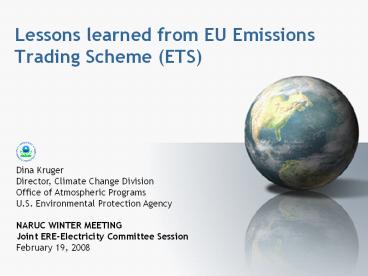Lessons learned from EU Emissions Trading Scheme (ETS) PowerPoint PPT Presentation
1 / 14
Title: Lessons learned from EU Emissions Trading Scheme (ETS)
1
Lessons learned from EU Emissions Trading Scheme
(ETS)
Dina Kruger Director, Climate Change
Division Office of Atmospheric Programs U.S.
Environmental Protection Agency NARUC WINTER
MEETING Joint ERE-Electricity Committee
Session February 19, 2008
2
Overview
- Background on EU Climate Policy
- EU Emission Trading Scheme (ETS)
- Lessons learned from Trial period of ETS
- Looking forward
3
European Union (EU)
- Within EU
- 27 Member states
- 23 countries have Kyoto targets as Annex B
parties, Malta and Cyprus do not have targets - Original 15 EU Member States have
- Collective Kyoto target of (8 below 1990
levels), but - Differentiated responsibilities under the EU
Burden Sharing Agreement
4
Emissions and GDP in 2005
EU emissions are 40 below US emissions while GDP
is about 10 higher than US GDP
5
EU Burden Sharing Agreement
6
EU Climate Change Policy
Overall EU Goal Reducing its overall emissions
to at least 20 below 1990 levels by 2020
- EU is using a portfolio of policies to meet goal
across all sectors through the EU Climate Change
Program (ECCP) - Cross-cutting cap and trade
- Regulation
- Incentives
- Voluntary approaches
- Updated goals and binding measures for ECCP
portfolio announced January 23, 2008 - Energy supply measures increase share of
renewable energy to 20 by 2020 - Energy demand measures 20 reduction in energy
consumption through energy efficiency - Transportation, buildings, agriculture reduce
emissions 10 below 2005 levels - Commitments by car makers to reduce CO2 emissions
rate from new passenger cars by 25 below 1995
levels by 2008/2009 - Increase share of sustainable biofuels to 10 of
overall petrol and diesel consumption - Improved EU ETS
Source Point Carbon, European Climate Change
Program, http//ec.europa.eu/environment/climat/e
ccp.htm
7
EU Emissions Trading Scheme (ETS)
- EU ETS currently addresses nearly 50 of all CO2
emissions (40 of total annual GHG emissions) - EU Directive currently outlines provisions for
initial trading periods - Trial period (2005-2007)
- First commitment period (2008-2012)
- Proposed amendment for third period (2013-2020)
with commitment for subsequent phases
8
EU Emissions Trading Scheme (ETS)
- 2005-2007 Trial Period
- Cap set by member states, 2.2 billion allowances
issued annually - Covers only CO2 emissions
- Coverage combustion and process emissions from
electricity generation and selected industries - Energy activities, mineral oil refineries, coke
ovens (installations with rated thermal input
20 MW) - Production and processing of ferrous metals
- Minerals industry (includes cement, glass,
ceramics, lime) - Pulp and paper production
- Point of regulation
- Downstream
- Allocation Approaches
- 95 of allowances must be allocated freely, 5
can be auctioned - Compliance and penalties
- Penalties 1st period 40/excess ton CO2
- 2008-2012 Kyoto Commitment Period
- Cap set by member states, 2.083 billion
allowances annually
9
Prices and Volumes
- General factors contributing to price volatility
- Fuel prices
- Weather
- Policy developments
10
Evaluating Emissions Trading
- Does it meet the environmental goal?
- Are caps achieved?
- Is monitoring accurate?
- Does the market work efficiently?
- Sufficient sources for a liquid market?
- Long-term certainty for investment planning?
- Is it a workable program administratively?
11
Trial Period Design and Implementation Lessons
- Lesson 1 Need high quality emissions data to set
environmental goals - Phase 1 caps based on limited data
- Phase 2 caps take advantage of better data
- Complementary policies needed for non-capped
sectors - Lesson 2 Consistency and predictability are
important - Large variability in allocation method among
member states - Failure to credit plant shutdowns creates
perverse incentives - Lesson 3 Keep scope manageable and consider
contribution to emissions - Inclusive of largest emitters and sufficient
sources for trading, but - Large number of small installations included
- 36 of total installations, responsible for
0.7 of emissions - 7.5 of total installations, responsible for 60
of emissions - Third phase of ETS will allow small installations
lt 25MW and emitting lt10,000 tons to opt out
12
Trial Period Design and Implementation Lessons
- Lesson 4 Need to have flexibility and provide
long term-certainty - Sources did not have temporal flexibility due to
lack of banking between phases - Phase 3 Trading extended to (2013-2020) for
long-term investment certainty - Banking will be allowed between Phase 2 and 3
- Lesson 5 Program implementation should be
efficient - Infrastructure for transfer of CDM credits not in
place - Monitoring protocols clear, but not all reporting
is electronic - Initial release of monitoring data not
coordinated - Role of third-party verifiers affects timing of
data submissions - Lesson 6 Transparency is important for
credibility - Functioning registry system to track allowances
and ownership, but allowance transfers are not
public data - Annual reporting (quarterly reporting in U.S.)
EU ETS is looking to harmonize program design
across all participating countries
13
EU Climate Policy Looking Forward
- Further improvements to EU ETS
- Single EU-wide cap instead of 27 national caps
- Average 1.846 billion metric tons CO2/year
- Increasing share of auctioning (full auctioning
of power sector allowances in 2013) - Community-wide new entrant reserve (5 of cap)
- Expanding to include other sectors and gases
- Aviation
- Aluminum (PFCs) and Chemicals (N2O)
- Recognize carbon capture and storage (CCS)
- Domestic Offsets?
- Linking
- Phase 2 Norway, Iceland, and Liechtenstein
- International Carbon Action Partnership (ICAP)
- Discussions with the Northeast Regional
Greenhouse Gas Initiative (RGGI), California,
Australia, New Zealand and Canadian Provinces - With global agreement, EU will commit to 30
below 1990 levels by 2020
14
For more information
- Point Carbon www.pointcarbon.com
- Caisse desDepots http//www.caissedesdepots.fr/
- EU ETS http//ec.europa.eu/environment/climat/emi
ssion.htm - Thank you!
- Dina Kruger
- Director, Climate Change Division
- Office of Atmospheric Programs
- kruger.dina_at_epa.gov
- www.epa.gov/climatechange

